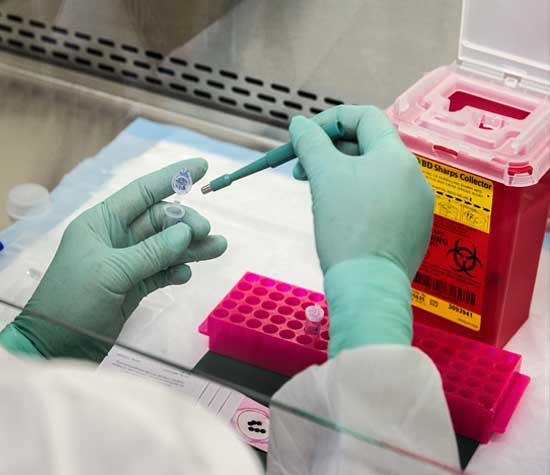Biohazardous Sharps Disposal
- Seal the sharps container lid, apply heat sensitive tape to the container, and autoclave for a minimum time of 30 minutes at 121°C and 15psi
- Label the container “autoclaved”
- Arrange for container pick up:
- Submit a Hazardous Materials Waste Pickup Request and note on the request that the material has been autoclaved, or
- Leave your autoclaved sharps container in the designated accumulation area in Bio II 4106, LSB 2204, or LSB 4218, where it will be picked up without a request.
Non-biohazardous laboratory sharps disposal procedures: Laboratory Sharps Disposal
Liquid Waste Collection in a Biological Safety Cabinet
Protect the laboratory vacuum system from contamination with a second flask and an inline HEPA filter. The primary flask contains full strength bleach and is used to collect spent media. The second flask collects any overflow. A HEPA filter is adjacent to the vacuum port for added protection. If one or both flasks are kept on the floor, they must be in a plastic container to prevent breakage.
Medical Waste Procedures
Solid waste is collected in red biohazard waste bags in secondary containment, treated at a minimum of 121°C for at least 30 minutes in an autoclave permitted with CDPH.
After the autoclave cycle has been confirmed, autoclaved waste is disposed of in the red or brown-lidded toters designated for laboratory waste.
Do not retain solid medical waste for longer than 7 days at room temperature.
Liquid waste is treated with an EPA-approved, tuberculocidal disinfectant and then dispensed down the laboratory sink with an excess of water. Tissue culture liquid waste is typically deactivated by aspirating it into 100% bleach. Add spent media until the bleach is diluted 10-fold to 10% final vol/vol, allow to set for a minimum of 20 minutes, and dispense down the laboratory sink with an excess of water.
Do not retain liquid medical waste for longer than 7 days at room temperature.
Trace chemotherapeutic and pharmaceutical waste, other than RCRA hazardous waste or Controlled Substances, is disposed of through EH&S as chemical hazardous waste. Residual solids and contaminated items (including sharps) are collected in a rigid, lidded container labeled with "CHEMO" on the Hazardous Waste Container label. Chemical hazardous waste must be picked up by EH&S Hazardous Waste within 270 days of the accumulation start date.
Biohazardous/medical sharps disposal procedures are described above, and the complete campus medical waste management plan is available on the Medical Waste tab.
Noninfectious Biological Waste
Not all biological waste is biohazardous, or infectious, medical waste, although it must be treated to deactivate cell cultures, genetically modified organisms, recombinant nucleic acids, cells expressing selectable markers, etc.
"Biotechnological" or noninfectious biological solid waste is collected in clear/white autoclave bags.
Examples of clear/white autoclave bag solid waste: vials containing transgenic fruit flies, plates of recombinant S. cerevisiae or E. coli K12, and well-characterized cell lines.
This waste may be autoclaved in any autoclave.
Best practices for steam sterilization are to treat at a minimum of 121°C for at least 30 minutes.
Autoclaved solid waste is disposed of in the red or brown-lidded wheeled lab waste toters.
